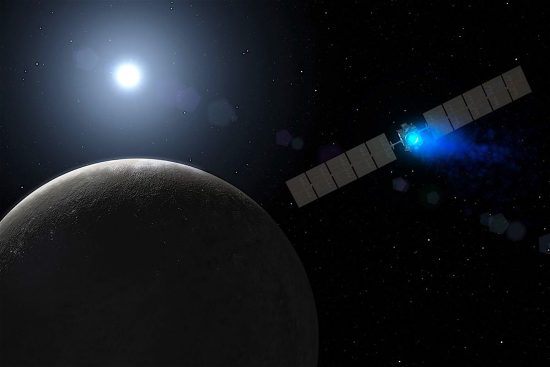
Artist’s impression of the Dawn spacecraft approaching Ceres. Credit: NASA/JPL-CalTech.
Nov 2, 2018
A scientific achievement comes to an end.
NASA launched the Dawn spacecraft on September 27, 2007. After orbiting the asteroid, Vesta until September 5, 2012 Dawn headed toward Ceres, the largest known asteroid in the Solar System, entering a high orbit on March 6, 2015. The mission officially ended in June of 2016, but Dawn’s hydrazine fuel supply was finally used-up on November 1, 2018. The spacecraft will continue orbiting Ceres for about 50 years, but it will remain unable to communicate, or charge its batteries.
One interesting discovery related to Vesta is meteorites recovered from the Antarctic ice that bear a striking resemblance to the spectrograms of Vesta’s surface. Known as HED meteorites, they are crystallized lava made up of howardite, eucrite, and diogenite. HED meteorites can be classified by where they came from. Gases trapped in some meteorites show that they came from Mars. HED meteorites are identified with Vesta. In most cases, HED meteorites show recrystallization that indicates Vesta’s regolith remelted at some time after its formation.
In an Electric Universe, gas giant planets are born from stars; not all are born at the same time. They are born hierarchically at intervals, and typically from within the parent. They are ejected. Gas giant planets like Jupiter and Saturn could have also ejected smaller minor planets and moons if they experienced an electrical input that caused them to suffer double layer breakdowns in their electromagnetic fields. Too much charge buildup will cause a large body’s plasma filaments to generate z-pinches, thus compressing the plasma into solid matter.
The charged bodies then accelerate in the electric field until they reach the gas giant’s surface and are shot into space. On their way out, they are pummeled by lightning bolts that rip and tear their exteriors, possibly melting them completely. Perhaps that is why most of the craters on Vesta and Ceres appear softened and rounded.
Ceres is roughly spherical, with a mean diameter of 950 kilometers. It is a dwarf planet, like Pluto and several recently discovered Trans-Neptunian Objects. Its size and density are similar to Saturn’s moons Tethys (1072 kilometers) and Dione (1120 kilometers). Since it compares with Pluto’s density of 1.88 g/cm³, there might be silicate rock beneath the ice. No one is sure, at this point.
The vast majority of its craters appear to be aligned with its center of gravity, which is an absurdity, because it means that every impact was at 90 degrees to its surface. As pointed out in previous Pictures of the Day, the craters have flat floors, scalloped edges, vertical sidewalls, craters on the rims of other craters, hexagonal formations, and crater chains. The crater alignment problem is solved if large craters on Ceres are electrical in nature.
Electrically excavated craters can be recognized by their steep sides, sharp rims, flat floors, and a lack of blast debris around them. Since electric arcs are constrained by electromagnetic fields, they are always aligned with the direction of the current, and forced to maintain right angles to the surface. Since two or more filaments rotate around an arc axis, its secondary discharge can excavate steep side walls. If the surface is negatively charged, an arc will travel, and might jump from high point to high point. Smaller craters on the rims of larger ones reveal this phenomenon. A series of craters in a line is another sign of arcing to a negatively charged substrate.
Occator crater, about 90 kilometers wide and four kilometers deep, gained fame because of a large, bright mound and bright patches inside it. The spots were initially thought by NASA team members to be water-ice, although Picture of the Day articles from that time insisted that there could be no open ice in a vacuum. The most obvious source for those comparatively bright areas was some kind of highly reflective dust. Ceres was found to be composed of carbonates and silicates, so that composition was a clue to the nature of the material: carbonates and silicates are white. Indeed, the patches are calcium and sodium carbonates.
Data from Dawn continues to be analyzed. More information will lead to further confirmation of the Electric Universe theory.
Stephen Smith












